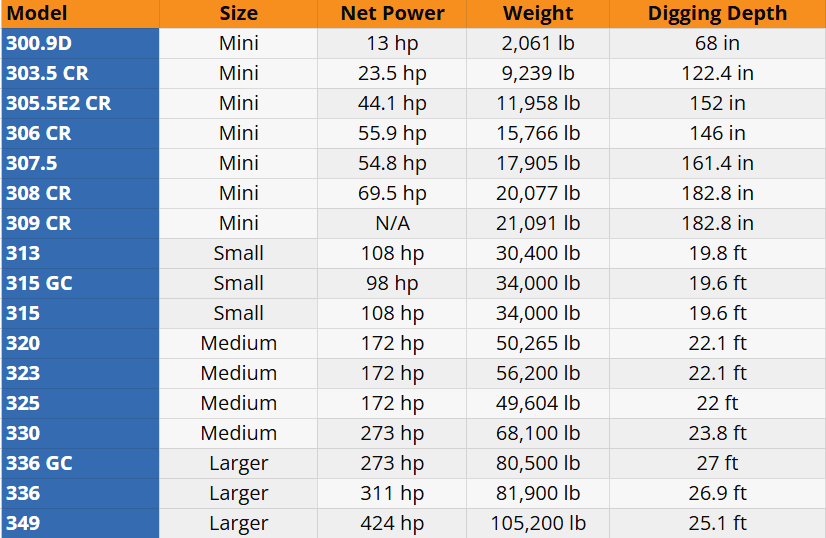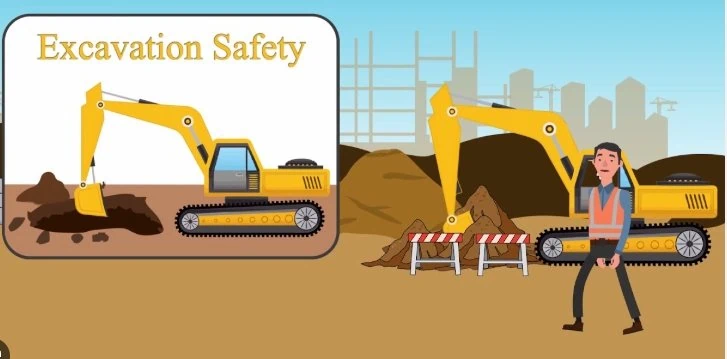Struggling to choose the right CAT excavator for your project? This blog post will provide a detailed comparison of CAT excavator sizes, helping you choose the most suitable excavator size and model for your needs. Whether your project is large or small, you can find the right machine here with us, greatly increasing your chances of success.
Cat Excavator Sizes
Caterpillar offers a wide range of excavator sizes, from mini to large excavators, catering to various construction needs. The smallest caterpillar in the world weighs less than 1,000 kg, and the largest Caterpillar excavator is the Caterpillar 6090 FS, which weighs more than 1,100 tons. Excavators are generally categorized based on operating weight, engine power, and digging depth.
Listed below are the weights that range for each CAT excavator size and what it is used for.
Choosing the correct excavator size according to the needs of construction is critical. Mini excavators, for instance, are often employed in urban construction and landscaping, but enormous digs are ideal for earthmoving projects, mining, and other tasks requiring heavy lifting.
When choosing an excavator size, you can consider a variety of factors. For example, the size of the construction site, how deep you plan to dig, and how much lifting capacity you need. Selecting the incorrect size may result in lost efficiency and higher expenditures.
Potential Issues When Choosing the Size of an Excavator?
Problem 1: Difficulty matching project scale with machine size
You may be unsure which size excavator is right for your project, especially when dealing with different construction requirements.
Problem 2: Concerns about the reliability of used equipment
Buyers often worry about the durability and remaining lifespan of used excavators.
Problem 3: Balancing budget and performance
Customers aim to find the most cost-effective machine, often debating between smaller and medium-sized models.
When you are hesitant about choosing the size of an excavator, you can contact our sales staff directly, and our team will select the most suitable excavator size and model for you.
CAT Excavator Size Chart
To help customers compare different models more effectively, the following table provides a detailed overview of some popular CAT excavator sizes, along with their operating weight, engine power, and maximum digging depth.Understanding the specific parameters and application areas for each model can help you assess whether it meets your project needs.

What Jobs Are Best Suited for Small CAT Excavators?
The small CAT excavator is highly flexible and can be easily operated even in narrow spaces. It weighs between 10 to 20 tons, offering more digging power and better lifting capacity compared to mini excavators. In landscaping tasks, small excavators can be used for digging, leveling ground, and moving materials. For urban construction, these compact machines help construction teams work efficiently in limited areas, ensuring that projects are completed on time. Their versatility and mobility make them an indispensable part of densely populated regions.
For example, the CAT 317 has 130 horsepower and weighs 40,200 pounds, allowing it to dig to a depth of 21 feet. It can work efficiently in spaces smaller than 15 feet, with a width of 8.8 feet, a height of 9.6 feet, and an overall length of 28.1 feet, making it ideal for compact construction environments.

When to Choose Medium CAT Excavators?
Medium CAT excavators are among the most commonly chosen machines for construction projects, suitable for a wide range of applications. Medium excavators, such as the CAT 320, are ideal for general earthmoving, construction, and road work. They offer a powerful combination of strength and flexibility, capable of handling various tasks effectively.
Medium excavators can efficiently manage different materials, such as soil, gravel, and concrete, making them perfect for construction sites and road projects. Their versatility allows operators to complete various tasks by changing attachments, such as buckets, breakers, and grapples. This adaptability contributes to their popularity in the construction industry.

Why Opt for Large CAT Excavators?
Large CAT excavators have unparalleled advantages in heavy construction projects. Large excavators, like the CAT 390, are suited for significant earthmoving, mining, and infrastructure construction, offering outstanding power and digging depth.
In mining and earthmoving projects, large excavators can handle heavier loads and achieve deeper digging depths, thereby enhancing construction efficiency. Although their operating costs are higher, the return on investment in large-scale projects often justifies the expense. Their capability to tackle demanding tasks makes them essential for major construction efforts.
Ensuring the Quality and Performance of Used CAT Excavators
Though used equipment comes at a lower cost, customers often worry about performance. To address these concerns, consider the following points when purchasing a used CAT excavator:
- Maintenance Records: Ensure the machine has a complete maintenance history to avoid heavily worn equipment.
- Engine and Hydraulic Systems: These are the core components of an excavator, so ensure they are functioning properly.
- Technical Inspections: Before purchasing, conduct a thorough technical inspection of the excavator’s key systems and performance.

Steps to Choosing the Right Excavator Size
Step 1: Assess project needs
The size of your project, terrain, and site conditions will determine the necessary excavator size. For small jobs, consider the CAT 301.7D, while medium projects may require the CAT 320.
Step 2: Determine a budget
Choose the best model based on your budget. Used excavators often provide a cost-effective solution.
Step 3: Check the performance of used equipment
Always review the maintenance records and mechanical condition before making a purchase.
Step 4: Consult with experts
If unsure, seek advice from experienced equipment suppliers who can provide expert recommendations.

Important Considerations
When choosing an excavator, take the following into account:
- Project requirements may change: Ensure the excavator has some level of flexibility and scalability to accommodate potential project changes.
- Parts availability: Make sure the spare parts for the model you choose are readily available for maintenance and repairs.
- Transportation and maintenance costs: Larger excavators require more resources for transportation and regular maintenance.
Conclusion and Recommendation
As the world’s leading excavator manufacturer, Caterpillar’s excavator quality is obvious to all. No matter what size excavator you want to choose, Caterpillar can provide you with the right model.
Hixen is a Chinese supplier of high-quality second-hand CAT excavators. If you need more information or professional advice about second-hand Cat excavators, please feel free to contact our staff. Our team is always ready to solve your problems.






